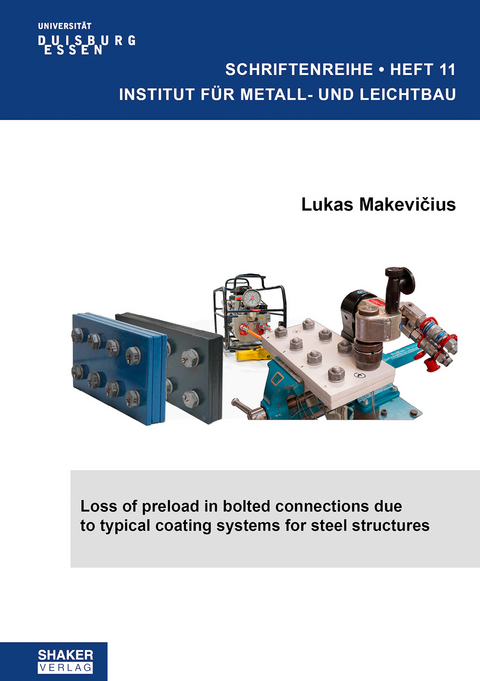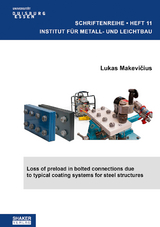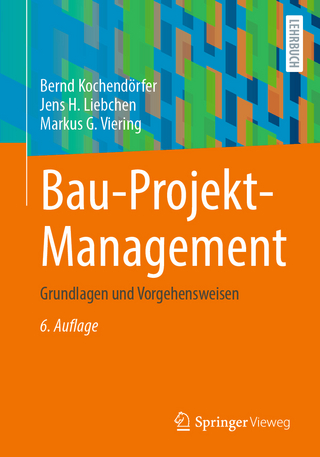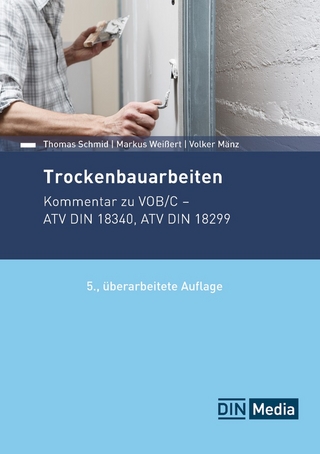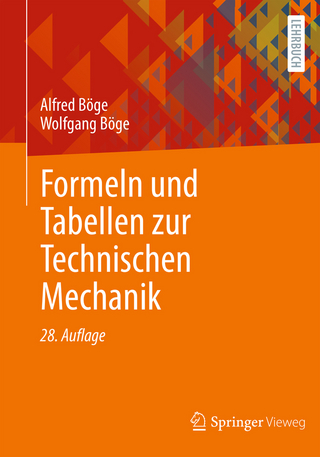Loss of preload in bolted connections due to typical coating systems for steel structures
Seiten
Bolted connections can be preloaded either to ensure the structural safety or to improve the serviceability e.g. by minimizing the slip or by increasing the deformation stiffness. According to DASt-Guideline 024, target level I of preloading and target level II of preloading can be distinguished.
A design of bolted connections with target level II of preloading is carried out without consideration of the actual amount of preload. However, the preloading force is directly included in the design verification for connections of target level I, so that the nominal value of preloading force should not only be reliably achieved during the tightening of a connection, but a sufficient level of preloading force considering the resulting preload losses must be ensured over the service life of the structure.
A sufficient design and execution of low-maintenance connections depend on the knowledge of several influencing factors, such as the reliability of different tightening methods with the associated system reserves and/or the estimated loss of preload over the service life. Since an assessment of potential preload losses is only possible to a very limited extent according to the current state of the art in steel construction, a development of suitable verification methods is necessary.
A comprehensive investigation was carried out in order to address the gap in the knowledge that currently exists for preloaded bolted connections. Herein, practically applicable solutions for a sufficient design and execution of low maintenance preloaded bolted connections in steel construction are provided based on the carried out estimation of the remaining preload level over the service life. Furthermore, an updated test procedure for the determination of preload losses is proposed.
A design of bolted connections with target level II of preloading is carried out without consideration of the actual amount of preload. However, the preloading force is directly included in the design verification for connections of target level I, so that the nominal value of preloading force should not only be reliably achieved during the tightening of a connection, but a sufficient level of preloading force considering the resulting preload losses must be ensured over the service life of the structure.
A sufficient design and execution of low-maintenance connections depend on the knowledge of several influencing factors, such as the reliability of different tightening methods with the associated system reserves and/or the estimated loss of preload over the service life. Since an assessment of potential preload losses is only possible to a very limited extent according to the current state of the art in steel construction, a development of suitable verification methods is necessary.
A comprehensive investigation was carried out in order to address the gap in the knowledge that currently exists for preloaded bolted connections. Herein, practically applicable solutions for a sufficient design and execution of low maintenance preloaded bolted connections in steel construction are provided based on the carried out estimation of the remaining preload level over the service life. Furthermore, an updated test procedure for the determination of preload losses is proposed.
| Erscheinungsdatum | 12.12.2023 |
|---|---|
| Reihe/Serie | Schriftenreihe Institut für Metall- und Leichtbau Universität Duisburg-Essen ; 11 |
| Verlagsort | Düren |
| Sprache | englisch |
| Maße | 148 x 210 mm |
| Gewicht | 495 g |
| Themenwelt | Technik ► Bauwesen |
| Schlagworte | Loss of Preload • Low-maintenance connections • Preloaded bolted connections • Preload losses • Slip Factor |
| ISBN-10 | 3-8440-9303-6 / 3844093036 |
| ISBN-13 | 978-3-8440-9303-2 / 9783844093032 |
| Zustand | Neuware |
| Informationen gemäß Produktsicherheitsverordnung (GPSR) | |
| Haben Sie eine Frage zum Produkt? |
Mehr entdecken
aus dem Bereich
aus dem Bereich
Grundlagen und Vorgehensweisen
Buch | Softcover (2021)
Springer Fachmedien Wiesbaden GmbH (Verlag)
37,99 €
Kommentar zu VOB/C ATV DIN 18340, ATV DIN 18299
Buch | Softcover (2024)
DIN Media (Verlag)
69,00 €
Buch | Softcover (2024)
Springer Vieweg (Verlag)
18,99 €
